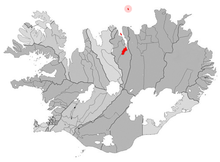Akureyri
| Akureyrarkaupstaður | |
|---|---|

Skyline of Akureyrarkaupstaður
|
|

Coat of Arms of Akureyri
|
|

Location of the Akureyri Municipality
|
|
| Region | Northeastern Region |
| Constituency | Northeast Constituency |
| Mayor | Eiríkur Björn Björgvinsson |
| Area | 138 km2 (53 sq mi) |
| Population | 18,191 |
| Density | 131.18/km2 (339.8/sq mi) |
| Municipal number | 6000 |
| Postal code(s) | 600, 601, 602, 603, 611, 630 |
| Website | akureyri |
Akureyri [ˈaːkʰʏrˌeiːrɪ] is a small city in northern Iceland. It is Iceland's second largest urban area (after the Capital Region) and fourth largest municipality (after Reykjavík, Hafnarfjörður, and Kópavogur).
Nicknamed the Capital of North Iceland, Akureyri is an important port and fishing centre. The area where Akureyri is located was settled in the 9th century but did not receive a municipal charter until 1786. The town was the site of Allied units during World War II. Further growth occurred after the war as the Icelandic population increasingly moved to urban areas.
The area has a relatively mild climate due to geographical factors, and the town's ice-free harbour has played a significant role in its history.
The Norse Viking Helgi magri (the slim) Eyvindarson originally settled the area in the 9th century. The first mention of Akureyri is in court records from 1562 when a woman was sentenced there for adultery. In the 17th century, Danish merchants based their camps at the current site of Akureyri, which was one of the numerous spits of land in Pollurinn. The main reasons for choosing this spot for trading operations were the outstanding natural harbour and the fertility of the area. The merchants did not live at Akureyri year-round but returned home in the winter.
Permanent settlement at Akureyri started in 1778, and eight years later, the town was granted its municipal charter by the king of Denmark (and at the time Iceland also) along with five other towns in Iceland. The king hoped to improve the living conditions of Icelanders by this action because at the time, Iceland had never had urban areas. As far as the king was concerned Akureyri was unsuccessful, because it did not grow from its population of 12. It lost its municipal status in 1836 but regained it in 1862. From then on Akureyri started to grow because of the excellent port conditions and perhaps more because of the productive agricultural region around it. Agricultural products became an important sector of the economy.
...
Wikipedia
